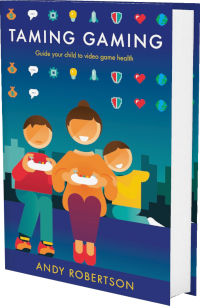 Android
Android iOS
iOS Mac
Mac Switch
Switch Wii
Wii Wii U
Wii U PC
PC PS4
PS4 PS5
PS5 Xbox One
Xbox One Xbox X|S
Xbox X|SWe've documented 35 accessibility features for The Cost of Recovery, including Fully Voiced (Or No Speech), Environmental Captions, Large Subtitles, Large Text and Low Pressure. Its accessibility is strongest in Controls and Reading but it also has features in Visual, Getting Started, Navigation and Audio to reduce unintended barriers.
This report is created with input from accessibility experts and the player community to help people find games that have the accessibility features they require. Once you have found potential games on the database, there are excellent specialist accessibility sites that offer in-depth reviews to guide your purchasing decisions.
Our accessibility examiner, Jo Robertson, first checked The Cost of Recovery accessibility 2 years ago.
 Accessibility Notes
Accessibility Notes
The game is designed to be easy so there are no difficulty settings. If you get stuck the game offers hints.
Can switch between Dolby, stereo and mono audio. When someone speaks the other audio is reduced and you can control how much this reduction is in the settings.
Captioning provides visual guidance for any audio happening off-screen due to the direction the player is looking.
 Game Details
Game Details
Release Date: Coming soon
Coming Soon: PC and Switch
Players: 1
Genres: Communication, Narrative and Puzzle
Accessibility: 35 features
Components: 3D Third-Person and Cartoon
Developer: Off The Btn Track (@OffTheBtnTrack)
Costs: Purchase cost
 Controls
Controls
We've documented 12 accessibility features for Controls in The Cost of Recovery which deal with how you control the game, different options for alternative inputs and whether you can remap these settings to suit your needs.
Gamepad
Can play with the following:
Multiple Buttons & Two Sticks: Can play with multiple buttons and two sticks.
Mouse And Keyboard
Can play with the following:
Mouse and Keys: Can play with mouse and multiple keys.
Remap Controls
Can customise the controls for the game as follows:
Select Preset Controller Mappings: You can select preset button layouts from options provided by the developer.
Remap Buttons: Can re-map all buttons so that you can use alternatives that better suit your play.
Swap Sticks: Can swap the sticks over so that you can use the opposite sticks to control the game.
Remap Sticks: Can remap the stick controls to controller buttons for easier access of direction controls.
Remap Mouse and Keyboard: Can remap mouse and keyboard key bindings, on systems that support these controls.
Remap Game Menu Access: Can remap buttons to pause, access and navigate the game menu. This enables you to specify which buttons pop-up the game menu.Whether you can remap menu navigation buttons isn't considered here.
Invert X/Y Axis: Can invert the direction required to control looking and aiming. This enables you to match your instinctive orientation when looking.
Controller Vibration
Vibration Optional: Controller vibration not used in the game or you can disable it.
Informative Vibration: Controller vibration indicates events or interactions in the game, echoing visual and audio cues. This can provide additional information about progress, approaching enemies or hitting a target.
Sensitivity
You can adjust
Adjust Mouse/Stick/Touch Sensitivity: Adjust how sensitive touch/mouse/stick controls are.
 Difficulty
Difficulty
We haven’t documented any accessibility features for Difficulty in The Cost of Recovery which deal with how you can adjust the challenge of play, and whether this is locked once chosen or can be adjusted as you play.
 Getting Started
Getting Started
We've documented 5 accessibility features for Getting Started in The Cost of Recovery which deal with what support is offered to get started with the game. This includes customising the experience when you first open the game via any onboarding processes it provides as well as tutorials and other assistance when you first start playing.
Assistance Getting Starting
These features aid your play of the game in terms of cognitive load on learning controls, dealing with pressure and coping with the environment and challenges.
Tutorials: There are helpful tutorials and instructions on how to play. Information is provided in a timely manner, with appropriate level of detail.
View Control Mapping: You can view a map of controls during play. This clearly displays the mappings of actions to buttons/keys/mouse/keyboard without having to leave the game. This includes games that always display buttons to press during play.
Low Pressure: Game tasks aren't time-limited or there's a low-pressure mode. This avoids the pressure of being put on the clock for overarching missions, or failing tasks because you didn't reach a destination in time.
Assistance For Progressing
These features aid your progress through the game offering different ways of maintaining your progression.
Assisted Progress With Hints: The game notices if you get stuck (or you can press a button) and provides information to help you progress. This can offer hints or tutorials popping up during play. This includes hints after you have died, where it can suggest strategies or difficulty settings to adjust or offer to skip past problematic levels.
Save Progress Anytime: The game automatically saves progress or you can save any time. This doesn’t mean you never lose progress, but it does mean you can stop whenever you want (without having to get to a save point) without losing progress.
 Reading
Reading
We've documented 7 accessibility features for Reading in The Cost of Recovery which deal with how much reading or listening comprehension is required, how well the game provides visual and audible access to the text and whether subtitles and captions are a good fit for purpose.
Reading Level
How much reading is required to play the game's main path or story and how complex the language is. The presence of voiced characters doesn't reduce this requirement, as it's recorded as a separate datapoint.
Moderate Reading: Moderate reading required. The quantity and complexity of reading are at a level that a high school student (14-year-old) would appreciate.
Text Visibility
Large Clear Text: All essential text is large and clear or can be adjusted to be. The general text used throughout the game in menus, instructions and other key information (excluding subtitles that are assessed separately) is at least 1/20 (46 pixels on 1080 screen) the height on landscape screens and at least 1/40 height on portrait screens. We base this on the full line-height, including the space above and below the letters.
High Contrast Text: Text colour contrasts to the background or can be adjusted to be. The text in menus, instructions and other information is presented in high contrast with a solid background.
Subtitles
Large Clear Subtitles: Subtitles are large, clear and of good contrast. They are at least 1/20 (46 pixels on 1080 screen) the height of a landscape screen and at least 1/40 height on portrait screens, or can be adjusted to be. We base this on the full line-height, including the space above and below the letters. Considered separately from the general text of the game, the subtitles are large, clear and of good contrast.
All Speech Subtitled (Or No Speech In Game): All spoken content has subtitles, or there is no speech in the game. This means there is no requirement to hear spoken dialogue or narrative to play the game.
Captions
Speaker Indicator, their Tone and Environment Sounds: Captions indicate who is speaking (or there is only ever one person speaking) and their tone, game sound and music. This can also be indicated visually in the game with character icons or character expressions with text in speech bubbles next to the person speaking. Environmental sounds are provided as extra text within the subtitles.
Voice Acted
All Dialogue is Voice Acted (Or No Speech In Game): All of the game dialogue and narrative can be voiced, or there is no speech in the game. This means there is no requirement to read the dialogue and narrative text to play the game.
 Navigation
Navigation
We've documented 3 accessibility features for Navigation in The Cost of Recovery which deal with how the game provides guidance and assistance to navigate its worlds. These are only for games that have traversal and exploration in 2D and 3D spaces.
Clarity
Large Clear Navigation: The in-game navigation and maps are clear to read. They offer large text and offer markers that are large and of high contrast. Where text or information is small, there are settings to zoom-in and increase visibility.
Head-Up Display
Adjust Head-Up Display: Resize and adjust the content of the head-up display. This enables it to be made more visible. It can also enable the removal of too much information that can be distracting or confusing.
Menu Navigation
Remap Game Menu Access: Can remap buttons to pause, access and navigate the game menu. This enables you to specify which buttons pop-up the game menu.Whether you can remap menu navigation buttons isn't considered here.
Similar Games With More Accessibility Features for Navigation
If you want to play The Cost of Recovery, but it doesn't offer the Navigation accessibility features you require, this similar game extends the Navigation accessibility:
- Venba (4 Navigation Features)
 Visual
Visual
We've documented 6 accessibility features for Visual in The Cost of Recovery which deal with how you can adjust the visuals to suit your needs, and offer additional information if you can't hear the game.
Interactive Elements
Outline Interactive Elements: Characters, platforms and enemies can be outlined or highlighted for visibility. This can be with a large border around the character or a special visual mode that adjust the colour to make characters more visible.
Visual Distractions
No Flashes: No flashing strobe effects or you can disable them. This includes the absence of flashing from dramatic visual effects, explosions or weather effects like lightning.
No Screen Shake: No screen shake effect or it is included but it can be disabled. This includes the absence of screen shake for dramatic effect as well as to indicate hits on a target.
Audio Cues for Visual Events
Audio Cues for Visual Events: Audio is provided to indicate visual events. Game events or progress highlighted by visual icons, effects or animations are also accompanied by audio to signify that progress. This is useful for blind players.
Audio Depiction of Event Location: Indication with positional/stereo audio of where directional events are on the screen for things like damage, footsteps, environmental elements. This is useful for blind players.
Colour Options
Colour Blind Friendly: Game doesn’t rely on colour or can switch to colour blind friendly mode with double coding or similar way to avoid colour dependance.
Similar Games With More Accessibility Features for Visual
If you want to play The Cost of Recovery, but it doesn't offer the Visual accessibility features you require, these similar games extend the Visual accessibility:
- Before Your Eyes (8 Visual Features)
- Venba (7 Visual Features)
- That Dragon, Cancer (7 Visual Features)
 Audio
Audio
We've documented 3 accessibility features for Audio in The Cost of Recovery which deal with how you can adjust the audio of the game and whether audio cues compensate for aspects of the game that are hard to see.
Adjustable Audio
Balance Audio Levels: Set music and game sound effects separately. This enables you to select your preference as well as ensure critical game sounds aren't obscured by other audio.
Audio Events
Visual Cues for Audio Events: Text or other visual indicators of audio events. This mirrors audio indicators of progress in the game with a corresponding visual indication.
Play Without Hearing
Play Without Hearing: No audio cues are necessary to play the game well.
System Accessibility Settings
In addition to the accessibility features provided in the game, you can also use system-wide accessibility settings:
Nintendo Switch
Nintendo Switch has some built-in features, including a lockable zoom, that can be used on all games.
PC
Windows has extensive accessibility features. Some, like colour correction, work with games. Lots of accessibility software can be used with PC games, from voice recognition to input device emulators.
Read more about system accessibility settings.
Accessibility Report supported by VSC Rating Board, PlayabilityInitiative and accessibility contributors Andy Robertson and Jo Robertson












